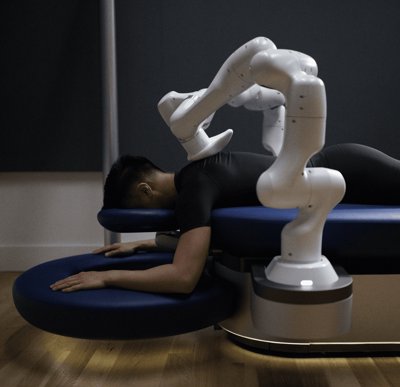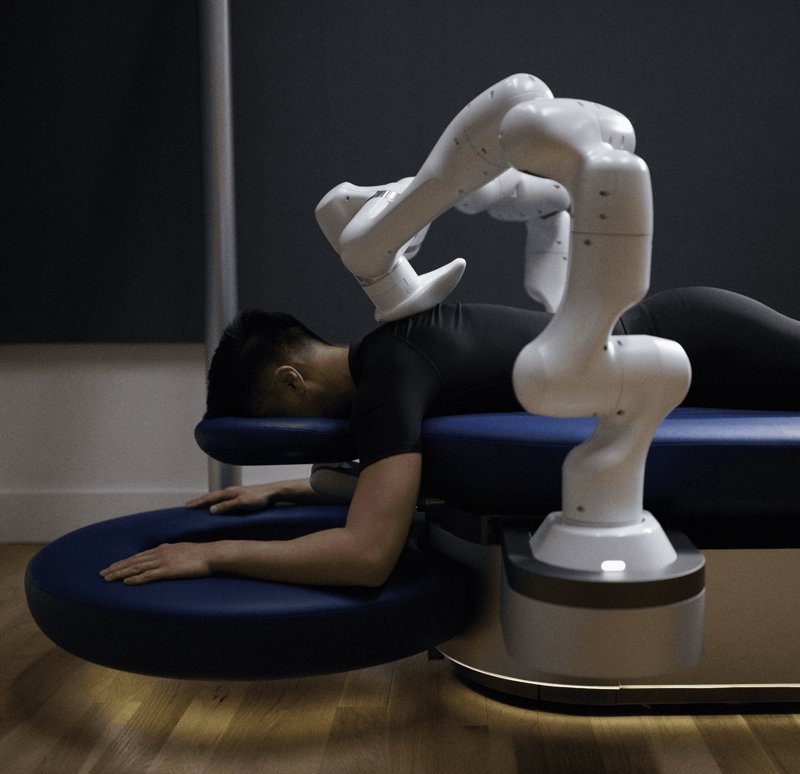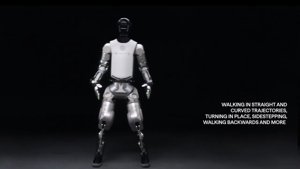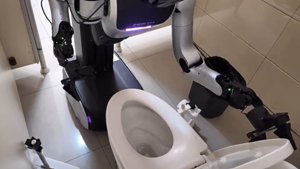Aescape Review: The Robot That’s Rubbing Out the Human Touch
Title: Robot Arms Offer Precision Massage, But Can They Replace Intuition? Description: A deep dive into Aescape’s $128M robotic massage table, trading human intuition for AI-driven, data-perfect muscle relief.

Overview
In the frantic quest for peak physical maintenance and recovery, humanity has gamely tried everything from goat yoga to plunging into liquid nitrogen. The newest contender entering the arena isn’t some exotic algae or another mindfulness application, but a pair of meticulously calibrated robotic arms. Say hello to Aescape, a New York-based lifestyle robotics outfit founded in 2017 by the indefatigable serial entrepreneur Eric Litman. The company’s grand mission is to solve a surprisingly stubborn conundrum plaguing the $19 billion massage industry: the gaping chasm of inconsistency. Aescape’s proposed fix is equal parts audacious and straight out of a Philip K. Dick novel: a fully autonomous, AI-driven massage plinth engineered to deliver a flawlessly bespoke session, every single time.
The sales pitch? Utterly intoxicating. Forget relying on the fluctuating skill set and ambient energy levels of a human practitioner. Aescape’s “Aertable” deploys AI and sophisticated sensors to conduct a full-body 3D scan, mapping over 1.2 million data points to create a precise blueprint of your muscular geography. From this data, two heated robotic appendages, tipped with what they call “Aerpoints,” commence their work, replicating seven distinct massage modalities. The entire symphony is orchestrated via a touchscreen, allowing users to dial the pressure up or down, or command a deeper focus on problem areas, mid-session. Aescape isn’t necessarily gunning for the total extinction of human therapists, but rather carving out a pristine new category of data-informed, on-demand physical well-being. It’s a move so bold it has already vacuumed up a staggering $128 million in venture capital from heavy hitters like Valor Equity Partners (who backed Tesla and SpaceX in their scrappy days) and NBA titan Kevin Love.
Key Points
- Inception: 2017, courtesy of serial entrepreneur Eric Litman in the concrete jungle of New York City.
- The Gimmick: AI-fuelled robotic massage promising hyper-personalised wellness and recovery protocols.
- The Engine Room: The Aertable leverages 3D body topography (1.2M data points!) and proprietary AI to choreograph massages delivered by twin heated robotic arms.
- The War Chest: Aescape has secured a cool $128 million across three funding rounds, with their most recent Series B in March 2025 netting $83 million.
- The Bankrollers: Valor Equity Partners, Alumni Ventures, and, yes, NBA Champion Kevin Love.
- The Target Zone: B2B dominance via luxury hotels, elite fitness centres, high-end spas, and corporate wellness schemes.
- Strategic Handshakes: A massive nationwide rollout with Equinox spanning 60 venues, alongside bespoke placements in select Four Seasons, Marriott, and Ritz-Carlton establishments.
- The Ritual: Users don the requisite “Aerwear” attire and use the touchscreen to dictate pressure, soundtrack, and areas of deep focus. Sessions are timed between 15 and 60 minutes.
Analysis
Genesis and The Long Game
Aescape was ignited by the quintessential founder’s affliction: Eric Litman—a four-time entrepreneur whose CV includes a stint working for the late Steve Jobs at NeXT and launching various tech ventures—suffered from a literal pain in the neck and the maddening inconsistency of the supposed cures. Founded in 2017, the company spent a solid seven years in the R&D shadows before its commercial unveiling. This lengthy incubation period speaks volumes about the monumental difficulty of programming a machine to safely and effectively manipulate the delicate architecture of the human body.
The company’s strategy has been laser-focused on symbiotic partnerships with established luxury and wellness monoliths, rather than battling the direct-to-consumer trenches—at least for now. They initiated their pilot program within select Equinox clubs in NYC, a launchpad that rapidly scaled into a 60-site national agreement. This success paved the way for inroads with opulent hospitality names like Four Seasons and Ritz-Carlton, cementing their dedication to the premium sector, where patrons are notoriously eager to shell out cash for novel, high-tech indulgences.
The Inner Workings and Shiny Bits
The core of the Aescape experience is its proprietary marriage of AI and computer vision. Before the kneading begins, the system constructs an intricate 3D topographical map of the user’s physique. Aescape asserts this goes beyond mere surface reading, supposedly discerning unique musculature and deep-seated tension points. This data feeds directly into a bespoke massage script executed by the dual robotic arms. The business end, the Aerpoints, are heated and calibrated to mimic the diverse strokes a seasoned human masseuse might employ.
The user remains the sovereign commander via the Aerview touchscreen interface. This element of interactivity is vital for overcoming the initial trust deficit. Users can view a live rendering of the arms’ activity, modulate the intensity, and even digitally “applaud” a particular manoeuvre to prompt the AI to repeat it. Safety is non-negotiable, featuring redundant pressure sensors and a panic button. Furthermore, Aescape insists on the Aerwear garments to guarantee the robotic implements glide frictionlessly and securely. This data-centric loop, where session preferences are permanently archived for future use, is the defining factor separating Aescape from the decidedly analog world of human touch therapy.
Where It Stands in the Marketplace
Aescape is busy staking out a brand new territory: “lifestyle robotics.” Its chief antagonist isn’t some rival automaton firm; it’s the entirety of the human-powered massage industry. Aescape has shrewdly positioned itself as the elegant antidote to the sector’s endemic labour crisis, which currently features over 29,000 vacant therapist roles. For their B2B clientele—the hotels and spas—the Aertable offers a consistent, always-available service that decouples revenue from staff scheduling woes.
While fringe players like Massage Robotics exist, Aescape appears to be the most heavily capitalised and commercially mature entity in this emerging field. Their B2B licensing structure, reportedly demanding about $7,500 per month per unit, enables swift market penetration without the logistical headache of direct consumer sales. The consumer entry point hovers around $60 for a half-hour session, positioning it as a competitive, perhaps even cheaper, alternative to a human massage in metropolitan hubs.
The Good, The Bad, and The Slightly Creepy
Strengths:
- Unwavering Consistency: The machine delivers the exact same standard of massage every single time, meticulously adhering to saved user profiles.
- Always On Call: It operates around the clock, immune to fatigue, directly tackling staffing shortages and catering to unsociable hours.
- Hyper-Personalisation: The AI mapping combined with user feedback creates a truly custom-tailored physical interaction.
- The Awkwardness Buffer: For individuals uncomfortable with human intimacy, especially regarding posterior regions, a robot offers a private, entirely non-judgmental service.
Challenges:
- The Ineffable Human Element: The primary barrier is psychological. Can a circuit board truly replicate the nuanced, empathetic intuition of a master therapist who can sense a knot you didn’t even know you possessed? Initial feedback is surprisingly warm, but consistently notes it’s a different sensation, not a direct substitute.
- The Initial Jolt of Fear: The visual of two powerful mechanical appendages moving over one’s body can be profoundly unsettling. Overcoming this initial “uncanny valley” factor is paramount for mass acceptance.
- The Price of Entry: The monthly licensing fee, while likely profitable for busy venues, represents a significant capital commitment for smaller enterprises.
- Geographical Limitations: For now, the therapeutic focus is largely confined to the back and glutes, falling short of the full-spectrum, holistic treatment many clients expect.
Verdict
Aescape is a genuinely captivating and brilliantly engineered answer to the “massage lottery” that plagues us all. The company has successfully navigated the treacherous engineering rapids required to build a robotic massage system that is simultaneously safe, precise, and effective. By strategically targeting elite B2B partners, they’ve tapped into a clientele primed to invest in technology promising unwavering reliability and instant access. The AI body mapping and user-centric controls are far beyond mere technological window dressing; they signify a true attempt to baptise wellness in the waters of data science.
However, Aescape’s most formidable opponent isn’t found in a patent filing; it’s philosophical. The very soul of a superior massage has always resided in the “human touch”—the innate sense of a therapist guiding your physical well-being. While users have expressed astonishment at how eerily human-like the experience can mimic certain strokes, it remains a flawless simulation. It lacks the easy banter, the comforting aroma of lavender oil, and the simple feeling of being cared for by another consciousness. It’s a more clinical, self-directed modality of physical maintenance.
Ultimately, Aescape is wagering that for the majority of users, cold, hard precision will triumph over intuitive empathy. This is built for the person who needs immediate relief after a brutal gym session without the headache of scheduling, or the jet-lagged executive requiring a kink removal at 11 PM sharp. Aescape has undeniably constructed the iPhone of massage tables: sleek, intelligent, and devastatingly capable. But whether you’re ready to trade your trusted human guru for an app-controlled automaton depends entirely on whether you’re seeking genuine therapy or simply a remarkably consistent, perfectly executed back rub.






